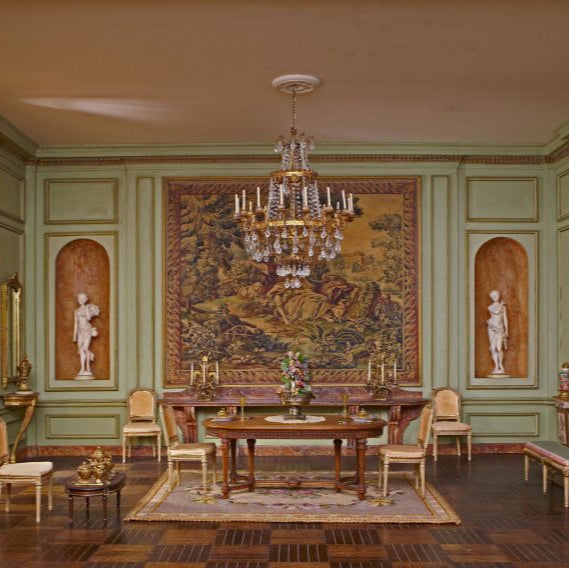The 68 miniature rooms conceived by Mrs. James Ward Thorne of Chicago and constructed between 1937 and 1940 have intrigued and delighted generations of visitors to the Art Institute. Take an armchair tour of interiors from the 16th century through the 1930s and American furnishings from the 17th century to 1940—all are insight-fully presented and chronicled in this revised edition.
Hardcover | 184 pages with 162 illustrations.
About the Thorne Rooms at Phoenix Art Museum:The Thorne Rooms represent a fascinating world in miniature. Visitors to Phoenix Art Museum have long been fascinated and delighted by the detail and precision with which very small artworks can be made. The Thorne Miniature Rooms represent a world in miniscule. Created at an exacting scale of one inch to one foot, several of the rooms replicate actual rooms found in the United States and Europe, while the remainder were inspired by the architecture and interior design of their respective periods and countries.
These rooms were conceived, designed, and in large part crafted by Narcissa Niblack Thorne (1882-1966). An Indiana native, Thorne began to collect miniature furniture and household accessories during her travels to England and Asia shortly after the turn of the 20th century.
Beginning in 1930, Thorne commissioned interiors scenes to contain her growing collection of miniature objects. At their tiny scale, some of the rooms even contain period-style rugs Thorne had woven specifically for each space. Thorne and the craftsmen with whom she worked completed nearly 100 rooms. Her hope was that perfectly proportioned rooms in miniature could substitute for costly and space-consuming full-scale period rooms that museums across the country were beginning to acquire. They also reflect the architectural revivals popular amongst wealthy patrons for their homes, and publicized in the shelter magazines of the period.
The original 30 Thorne Miniature Rooms were displayed at the 1933 Chicago Century of Progress Exposition and they gained national attention when featured in a 1940 LIFE Magazine article. In 1962, Thorne donated 20 of the original 30 rooms to a fledgling Phoenix Art Museum, then celebrating its third anniversary, and the rooms have been on view since that time.
Collections: American + Western American Books The Thorne Miniature Rooms
Shipping and handling rates are based on weight and destination. All orders are shipped via USPS or UPS. When possible, our orders are packaged with recycled materials to reduce waste and additional costs. Orders over $150 may be sent signature required at our discretion.
We do offer express shipments through UPS 2 and 3 Day Air. We also offer shipping via USPS Priority Mail (1-3 days to most US locations.)
We ship all international orders with tracking to your address via USPS. Most products can be shipped to international addresses. Recipient is responsible for all applicable customs duties, tariffs, taxes or Value Added Tax (VAT), which are collected by the carrier upon delivery. Shipping rates are calculated based on weight and destination.
For additional information, please contact The Museum Store at store@phxart.org.
In-store pickup is available on most items at no charge by selecting the pickup option at checkout. An email notification is generated and sent as soon as items are packaged and ready for pickup.
Pickup is available Wednesday - Sunday, 10am - 5pm. Please visit The Museum Store or park near the red dinosaur sculpture on the north side of The Museum and call 602-257-2182 when you arrive. We can bring your items out to you.
An additional email notification will be sent for any items not picked up after 10 days of order receipt.
Orders not picked up after 20 days of order receipt will receive a final email notification.
Items not picked up after 30 days of order receipt will be considered abandoned and processed as a donation to The Museum.
Please inspect your order upon delivery. If you are not completely satisfied with your purchase, you may return the merchandise for a replacement, exchange, or refund within 30 days of purchase with the original receipt and product tag attached.
Clearance items and consumables such as nail polish and perfume are final sale and non-returnable. Gift recipients will receive a merchandise credit in the form of a Museum Store gift card.
Museum Store Returns
1625 N Central Avenue
Phoenix, Arizona 85004
Tel. 602-257-2182
The Thorne Rooms provide a glimpse into replications of rooms found in America and Europe, at an exacting 1:12 scale. A beloved favorite of visitors of all ages, they have been painstakingly preserved for nearly a century.
The Thorne Rooms provide a glimpse into replications of rooms found in America and Europe, at an exacting 1:12 scale. A beloved favorite of visitors of all ages, they have been painstakingly preserved for nearly a century.
Members of Phoenix Art Museum save 10% off all regularly priced merchandise!
Members of Phoenix Art Museum save 10% off all regularly priced merchandise!
Receive fun and informational emails about art-inspired gifts, free shipping days, sales and more! You'll receive between 2 and 3 emails per month throughout the year, plus a few extra during special shopping holidays.
